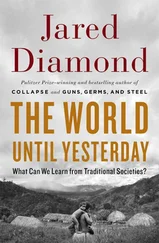Jared Diamond - Guns, Germs & Steel
Здесь есть возможность читать онлайн «Jared Diamond - Guns, Germs & Steel» весь текст электронной книги совершенно бесплатно (целиком полную версию без сокращений). В некоторых случаях можно слушать аудио, скачать через торрент в формате fb2 и присутствует краткое содержание. Жанр: 105. Описание произведения, (предисловие) а так же отзывы посетителей доступны на портале библиотеки ЛибКат.
- Название:Guns, Germs & Steel
- Автор:
- Жанр:
- Год:неизвестен
- ISBN:нет данных
- Рейтинг книги:5 / 5. Голосов: 1
-
Избранное:Добавить в избранное
- Отзывы:
-
Ваша оценка:
- 100
- 1
- 2
- 3
- 4
- 5
Guns, Germs & Steel: краткое содержание, описание и аннотация
Предлагаем к чтению аннотацию, описание, краткое содержание или предисловие (зависит от того, что написал сам автор книги «Guns, Germs & Steel»). Если вы не нашли необходимую информацию о книге — напишите в комментариях, мы постараемся отыскать её.
Guns, Germs & Steel — читать онлайн бесплатно полную книгу (весь текст) целиком
Ниже представлен текст книги, разбитый по страницам. Система сохранения места последней прочитанной страницы, позволяет с удобством читать онлайн бесплатно книгу «Guns, Germs & Steel», без необходимости каждый раз заново искать на чём Вы остановились. Поставьте закладку, и сможете в любой момент перейти на страницу, на которой закончили чтение.
Интервал:
Закладка:
FURTHER READINGS • 443
the New World?" American Journal of Respiratory Critical Care Medicine 151:1267-68 (1995).
Chapter 12
Books providing general accounts of writing and of particular writing systems include David Diringer, Writing (London: Thames and Hudson, 1982), I. J– Gelb, A Study of Writing* 2nd ed. (Chicago: University of Chicago Press, 1963), Geoffrey Sampson, Writing Systems (Stanford: Stanford University Press, 1985), John DeFrancis, Visible Speech (Honolulu: University of Hawaii Press, 1989), Wayne Senner, ed., The Origins of Writing (Lincoln: University of Nebraska Press, 1991), and J. T. Hooker, ed., Reading the Past (London: British Museum Press, 1990). A comprehensive account of significant writing systems, with plates depicting texts in each system, is David Diringer, The Alphabet, 3rd ed., 2 vols. (London: Hutch-inson, 1968). Jack Goody, The Domestication of the Savage Mind (Cambridge: Cambridge University Press, 1977), and Robert Logan, The Alphabet Effect (New York: Morrow, 1986), discuss the impact of literacy in general and of the alphabet in particular. Uses of early writing are discussed by Nicholas Postgate et al., "The evidence for early writing: Utilitarian or ceremonial?" Antiquity 69:459-80 (1995).
Exciting accounts of decipherments of previously illegible scripts are given by Maurice Pope, The Story of Decipherment (London: Thames and Hudson, 1975), Michael Coe, Breaking the Maya Code (New York: Thames and Hudson, 1992), John Chadwick, The Decipherment of Linear B (Cambridge: Cambridge University Press, 1992), Yves Duhoux, Thomas Palaima, and John Bennet, eds., Problems in Decipherment (Louvain-la-Neuve: Peeters, 1989), and John Justeson and Terrence Kaufman, "A decipherment of epi-Olmec hieroglyphic writing," Science 259:1703-11 (1993).
Denise Schmandt-Besserat's two-volume Before Writing (Austin: University of Texas Press, 1992) presents her controversial reconstruction of the origins of Sumerian writing from clay tokens over the course of nearly 5,000 years. Hans Nissen et al., eds., Archaic Bookkeeping (Chicago: University of Chicago Press, 1994), describes Mesopotamian tablets that represent the earliest stages of cuneiform itself. Joseph Naveh, Early History
444 " FURTHER READINGS
of the Alphabet (Leiden: Brill, 1982), traces the emergence of alphabets in the eastern Mediterranean region. The remarkable Ugaritic alphabet is the subject of Gernot Windfuhr, "The cuneiform signs of Ugarit," Journal of Near Eastern Studies 29:48-51 (1970). Joyce Marcus, Mesoamerican Writing Systems: Propaganda, Myth, and History in Four Ancient Civiliza tions (Princeton: Princeton University Press, 1992), and Elizabeth Boone and Walter Mignolo, Writing without Words (Durham: Duke University Press, 1994), describe the development and uses of Mesoamerican writing systems. William Boltz, The Origin and Early Development of the Chinese Writing System (New Haven: American Oriental Society, 1994), and the same author's "Early Chinese writing," World Archaeology 17:420-36 (1986), do the same for China. Finally, Janet Klausner, Sequoyah's Gift (New York: HarperCollins, 1993), is an account readable by children, but equally interesting to adults, of Sequoyah's development of the Cherokee syllabary.
Chapter 13
The standard detailed history of technology is the eight-volume A History of Technology, by Charles Singer et al. (Oxford: Clarendon Press, 1954-84). One-volume histories are Donald Cardwell, The Fontana History of Technology (London: Fontana Press, 1994), Arnold Pacey, Tech nology in World Civilization (Cambridge: MIT Press, 1990), and Trevor Williams, The History of Invention (New York: Facts on File, 1987),; R. A. Buchanan, The Power of the Machine (London: Penguin Books,,; 1994), is a short history of technology focusing on the centuries since A.D.| 1700. Joel Mokyr, The Lever of Riches (New York: Oxford University*! Press, 1990), discusses why the rate of development of technology has va ied with time and place. George Basalla, The Evolution of Technolog (Cambridge: Cambridge University Press, 1988), presents an evolutionatf| view of technological change. Everett Rogers, Diffusion of Innovatic 3rd ed. (New York: Free Press, 1983), summarizes modern research on l transfer of innovations, including the QWERTY keyboard. David He loway, Stalin and the Bomb (New Haven: Yale University Press, 199 dissects the relative contributions of blueprint copying, idea diffusion p espionage), and independent invention to the Soviet atomic bomb.
Preeminent among regional accounts of technology is the series
FURTHER READINGS • 445
and Civilization in China, by Joseph Needham (Cambridge: Cambridge University Press), of which 5 volumes in 16 parts have appeared since 1954, with a dozen more parts on the way. Ahmad al-Hassan and Donald Hill Islamic Technology (Cambridge: Cambridge University Press, 1992), and K. D. White, Creek and Roman Technology (London: Thames and Hudson, 1984), summarize technology's history for those cultures.
Two conspicuous examples of somewhat isolated societies adopting and then abandoning technologies potentially useful in competition with other societies involve Japan's abandonment of firearms, after their adoption in a.d. 1543, and China's abandonment of its large oceangoing fleets after a.d. 1433. The former case is described by Noel Perrin, Giving Up the Gun (Boston: Hall, 1979), and the latter by Louise Levathes, When China Ruled the Seas (New York: Simon and Schuster, 1994). An essay entitled "The disappearance of useful arts," pp. 190-210 in W. H. B. Rivers, Psychology and Ethnology (New York: Harcourt, Brace, 1926), gives similar examples among Pacific islanders.
Articles on the history of technology will be found in the quarterly journal Technology and Culture, published by the Society for the History of Technology since 1959. John Staudenmaier, Technology's Storytellers (Cambridge: MIT Press, 1985), analyzes the papers in its first twenty years.
Specific fields providing material for those interested in the history of technology include electric power, textiles, and metallurgy. Thomas Hughes, Networks of Power (Baltimore: Johns Hopkins University Press, 1983), discusses the social, economic, political, and technical factors in the electrification of Western society from 1880 to 1930. Dava Sobel, Longi tude (New York: Walker, 1995), describes the development of John Har-nson's chronometers that solved the problem of determining longitude at sea. E. J. W. Barber, Prehistoric Textiles (Princeton: Princeton University Press, 1991), sets out the history of cloth in Eurasia from its beginnings more than 9,000 years ago. Accounts of the history of metallurgy over wide regions or even over the world include Robert Maddin, The Begin ning of the Use of Metals and Alloys (Cambridge: MIT Press, 1988), Theodore Wertime and James Muhly, eds., The Coming of the Age of Iron (New Haven: Yale University Press, 1980), R. D. Penhallurick, Tin in Antiquity (London: Institute of Metals, 1986), James Muhly, "Copper and ln, Transactions of the Connecticut Academy of Arts and Sciences 3;155-535 (1973), and Alan Franklin, Jacqueline Olin, and Theodore
Интервал:
Закладка:
Похожие книги на «Guns, Germs & Steel»
Представляем Вашему вниманию похожие книги на «Guns, Germs & Steel» списком для выбора. Мы отобрали схожую по названию и смыслу литературу в надежде предоставить читателям больше вариантов отыскать новые, интересные, ещё непрочитанные произведения.
Обсуждение, отзывы о книге «Guns, Germs & Steel» и просто собственные мнения читателей. Оставьте ваши комментарии, напишите, что Вы думаете о произведении, его смысле или главных героях. Укажите что конкретно понравилось, а что нет, и почему Вы так считаете.










